This entry was posted on November 4, 2024 by Charlotte Bell.

Side Plank Pose (Vasisthasana) is a core strengthening powerhouse. But the core muscles aren’t the only ones that engage in the pose. Practicing the side plank can also improve strength in your knees, back, shoulders, and glutes.
The tradition behind many yoga asanas is fascinating and can give you insight into how to approach each pose. Vasisthasana is named after a sage named Vasistha. This link tells the story of Vasisthasana, named after the sage Vasistha and his “cow of abundance”.
Benefits of side plank pose
Side plank pose is one of the “all over” poses in yoga. When we practice alignment carefully and attentively, the entire body can benefit. Here are some of the benefits:
- Basic strength: Vasisthasana supports balance and posture by strengthening your body.
- Oblique force: Side planks are one of the rare poses that strengthen the obliques.
- Glute Strength: Strengthening your glutes helps stabilize your hip joints.
- Spinal stability: Side planks activate your abdominal muscles, back, hips, legs and shoulders, which can stabilize your spine.
- Adductor muscle strength: Strengthening your adductors can help stabilize your knees and hips.
- Knee stability: Side planks strengthen the gluteus medius and gluteus minimus, which helps stabilize the knees.
Precautions for installing side boards
Like all yoga poses, Side Plank Pose, it is important to avoid Side Plank Pose in certain circumstances. Here are some of them:
- Active hand and wrist injuries or conditions such as carpal tunnel syndrome
- Medical conditions such as a hernia, heart problems, or non-medicated high blood pressure
- Recent surgery on knees, hips, spine, abdomen, shoulders or wrists
- Avoid practicing side plank pose if you are pregnant, especially during the first trimester.
- It’s rare for this to happen, but if your body tends to move the ribs, side plank poses are not recommended.
As always, in every yoga pose, if you feel any pain during Vasisthasana, exit the pose immediately.
Side Plank Variation
Practicing the side plank variation I’m offering today can help alleviate some of the challenges of practicing the traditional pose. The added support for your front foot helps take some of the weight off the hands, wrists and back foot. I still advise you to practice with caution – or not at all – if you experience any of the above conditions. But if the traditional pose seems too difficult or out of reach for you, this variation will give you the opportunity to reap the same benefits without the potential stress.
How to Practice the Side Plank Variation
- Spread a non-slip yoga mat on the floor.
- Sit sideways on your yoga mat, placing your left hand on the floor with your arm extended, just under your shoulder. Your torso should be mostly vertical and your legs horizontal.
- With the outside of your left leg extended on your mat, place your right leg on top of it.
- Now, step your right foot forward so that your foot is at a 90-degree angle to your left leg. Your heel should be about a foot in front of your left thigh.
- Now press your left hand, right foot, and the outside of your left foot to lift the body into a plank.
- Raise your right arm toward the sky or feel free to place your hand on your right hip.
- Stay for three to five deep breaths before lowering back to the floor.
- Repeat on the other side.
If this seems too taxing for your hand and wrist, feel free to practice on your forearm, like this:

About Charlotte Bell
Charlotte Bell discovered yoga in 1982 and began teaching in 1986. Charlotte is the author of Mindful Yoga, Mindful Life: A Guide for Everyday Practice, and Yoga for Meditators, both published by Rodmell Press. Her third book is Hip-Healthy Asana: The Yoga Practitioner’s Guide to Protecting the Hips and Avoiding SI Joint Pain (Shambhala Publications). She writes a monthly column for CATALYST magazine and is the editor-in-chief of Yoga U Online. Charlotte is a founding board member of GreenTREE Yoga, a nonprofit organization that brings yoga to underserved populations. A lifelong musician, Charlotte plays oboe and English horn in the Salt Lake Symphony and the folk sextet Red Rock Rondo, whose DVD won two Emmy Awards.
